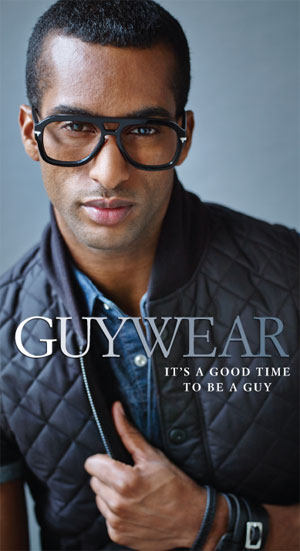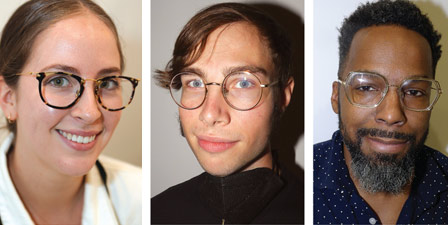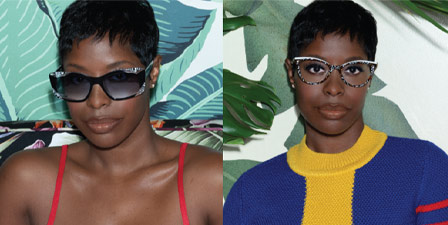
Once upon a time, fashion was men’s domain. Long before there were “fashionistas,” there were “dandies” who crafted and refined enough rules to regulate menswear so there are still entire books published for those who need to know the appropriate sports coat pattern to wear to an outdoor party in the country (it’s glen plaid). Somewhere along the line though, men quite simply gave up their grip on fashion, quietly surrendering the baton of innovation to retreat to their man caves. While Peter Pan collars and handkerchief cuts emerged as ways for women to experiment with their appearance, menswear stagnated, and even accessories took over as a largely feminine domain: Pocket squares and cufflinks aside, there’s not really much that a man can do to snazz up an outfit, and even then, it’s got to be something on the dressier end of the spectrum. Unless you were planning on heading to the office or hitting a particularly trendy nightspot, it’s been far more difficult to play with your outfit the way your wife or girlfriend can. In the past few years though, that’s changed in a very profound way—and it’s all thanks to eyewear.
Maybe it was the aftereffects of the fashion hangover collectively referred to as “the ’90s.” Maybe it had something to do with a “Fight Club”-style primordial yearning to reclaim clothing as an acceptable means of individual expression...maybe guys just simply got bored. Whatever the motivation, men came to a realization in the early 2000s: Glasses are the ultimate accessory. Find the right pair (or two), and you’ve got the perfect way to sum up your personality with one small piece that also plays with your angles just right AND goes with everything. At first, frame manufacturers were slow to respond, as “frame styling” was seen solely as the realm of the nascent metrosexual movement and men outside the mainstream. Then figuring that nothing could be uglier than those massive aviators they were wearing in high school, otherwise sartorially conservative men figured “why not” and took the plunge. Thus exploded a design firestorm that has produced a veritable frame renaissance. While women had rarely been hard-pressed for a variety of styles to choose from when selecting eyewear, men were getting their first opportunity in decades to really pick a pair of frames that made a statement about themselves. The bland, metal rectangles and teensy plastic frames that had defined men’s eyewear in the ’90s were out the window. Gone was the concept of finding the pair of frames that would help to blend in with the crowd. Here to stay were bold, assertive glasses; frames with personality, frames that said, “Here I am.” (And make no mistake, we’re not just talking plastics. Subtle as they were, even Steve Jobs’ trademark Robert Marc rimless made a statement because of its understatedness, rather than in spite of it.)
Demonstrating that history truly does repeat itself, women today are increasingly flocking toward frames initially designed with men in mind, resulting in numerous offshoot designs being released to appease female patients. Like blue jeans, neckties, vests and numerous other staples of Diane Keaton’s wardrobe, most of today’s premier eyeglass styles started out as men’s eyewear before diversifying into unisex and women’s styles, which then came to dominate the eyewear scene. For example, browlines were strictly mens’ fare when Shuron Optical debuted them in 1947, and a glimpse back at Buddy Holly album covers and Jack Lord in “Dr. No” shows that for a brief, confusing moment, cateyes were—for some reason—considered a manly alternative to more conventional styles. Art-Craft Optical then made the brow a feminine article with its Leading Lady line of frames, causing other manufacturers to follow suit with their own women’s browlines. Meanwhile, cooler heads prevailed on the cateye front, as it was forever decided that the style was more befitting of sassy librarians and female executives than it was square-jawed secret agents (sorry, Jack).
Designs aside, let’s not forget colors, either. With most of our photos from the ’50s and ’60s being in black and white, it’s easy to forget that a great many frames of the day weren’t bland, black plastics, but surprisingly, came available to patients in a thrilling array of colors and patterns incongruous to the more toned-down aesthetics of the era. Today’s frames are recapturing that excitement through their artful exploration of the color wheel. Olive frames began to pop up in in 2012, and navy blue positively exploded in 2013, demonstrating that while it may be a conservative shade for a suit, it’s becomes much more exciting when it’s framing your eyes.
The power of men’s eyewear stretches beyond simply ophthalmic frames too. Take a look at the sunglass styles that have come to dominate the market in 2013, and you’ll find that a great many of them began as men’s eyeglass styles. Two styles currently cornering the sun market are most familiar to us from the men’s corner of the dispensary—our beloved browlines and the P3, aka the shape that won World War II. Another style catching on of late in sunwear is the fade—a fashion first introduced in the ’60s in order to allow men to make the transition from browlines to zyls without abandoning the look to which they’d become accustomed.
What’s the final word on men’s eyewear in 2013? Well, for the time being, there isn’t one. The design train shows no signs of slowing down, with 2014 promising to take us in new, fascinating directions. (My own prediction: The return of the plastic aviator. Don’t laugh. It’s happening.) So let us fluff our beards, raise a glass of manly brew and straighten our frames: With all of the options available to us in the dispensary, it truly is a good time to be a guy.■













